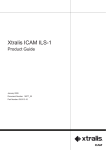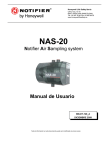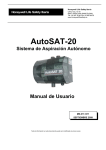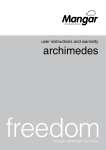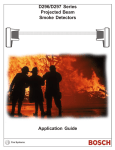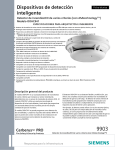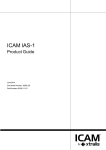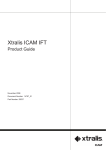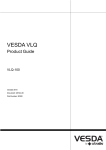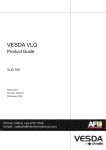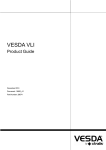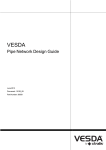Download 20635_00_Xtralis_XAS..
Transcript
Xtralis XAS-1-US Product Guide December 2011 Document: 20635_00 Part Number: 29875 Xtralis Pty Ltd XAS-1-US Product Guide Intellectual Property and Copyright This document includes registered and unregistered trademarks. All trademarks displayed are the trademarks of their respective owners. Your use of this document does not constitute or create a licence or any other right to use the name and/or trademark and/or label. This document is subject to copyright owned by Xtralis AG (“Xtralis”). You agree not to copy, communicate to the public, adapt, distribute, transfer, sell, modify or publish any contents of this document without the express prior written consent of Xtralis. Disclaimer The contents of this document is provided on an “as is” basis. No representation or warranty (either express or implied) is made as to the completeness, accuracy or reliability of the contents of this document. The manufacturer reserves the right to change designs or specifications without obligation and without further notice. Except as otherwise provided, all warranties, express or implied, including without limitation any implied warranties of merchantability and fitness for a particular purpose are expressly excluded. General Warning This product must only be installed, configured and used strictly in accordance with the General Terms and Conditions, User Manual and product documents available from Xtralis. All proper health and safety precautions must be taken during the installation, commissioning and maintenance of the product. The system should not be connected to a power source until all the components have been installed. Proper safety precautions must be taken during tests and maintenance of the products when these are still connected to the power source. Failure to do so or tampering with the electronics inside the products can result in an electric shock causing injury or death and may cause equipment damage. Xtralis is not responsible and cannot be held accountable for any liability that may arise due to improper use of the equipment and/or failure to take proper precautions. Only persons trained through an Xtralis accredited training course can install, test and maintain the system. Liability You agree to install, configure and use the products strictly in accordance with the User Manual and product documents available from Xtralis. Xtralis is not liable to you or any other person for incidental, indirect, or consequential loss, expense or damages of any kind including without limitation, loss of business, loss of profits or loss of data arising out of your use of the products. Without limiting this general disclaimer the following specific warnings and disclaimers also apply: Fitness for Purpose You agree that you have been provided with a reasonable opportunity to appraise the products and have made your own independent assessment of the fitness or suitability of the products for your purpose. You acknowledge that you have not relied on any oral or written information, representation or advice given by or on behalf of Xtralis or its representatives. Total Liability To the fullest extent permitted by law that any limitation or exclusion cannot apply, the total liability of Xtralis in relation to the products is limited to: i. in the case of services, the cost of having the services supplied again; or ii. in the case of goods, the lowest cost of replacing the goods, acquiring equivalent goods or having the goods repaired. Indemnification You agree to fully indemnify and hold Xtralis harmless for any claim, cost, demand or damage (including legal costs on a full indemnity basis) incurred or which may be incurred arising from your use of the products. Miscellaneous If any provision outlined above is found to be invalid or unenforceable by a court of law, such invalidity or unenforceability will not affect the remainder which will continue in full force and effect. All rights not expressly granted are reserved. www.xtralis.com i XAS-1-US Product Guide Xtralis Pty Ltd Document Conventions The following typographic conventions are used in this document: Convention Description Bold Used to denote: emphasis Used for names of menus, menu options, toolbar buttons Italics Used to denote: references to other parts of this document or other documents. Used for the result of an action. The following icons are used in this document: Convention Description Caution: This icon is used to indicate that there is a danger to equipment. The danger could be loss of data, physical damage, or permanent corruption of configuration details. Warning: This icon is used to indicate that there is a danger of electric shock. This may lead to death or permanent injury. Warning: This icon is used to indicate that there is a danger of inhaling dangerous substances. This may lead to death or permanent injury. Contact Us The Americas +1 781 740 2223 Asia +852 2916 8894 Australia and New Zealand +61 3 9936 7000 Europe, Middle East & Africa +44 1442 242 330 www.xtralis.com ii www.xtralis.com Xtralis Pty Ltd XAS-1-US Product Guide Regional Regulatory Requirements and Notices UL The XAS-1-US is UL Listed as a Smoke Detector for Special Application installations. It is also suitable for Open Area Protection using the following detector sensitivity ranges: Detector Sensitivity Range Air Velocity Range(s) Apollo Series 65 55000-327 1.00 %/ft – 1.4 %/ft 0 – 2000 FPM Apollo XP95 Analog 55000-650 1.30 %/ft – 3.43 %/ft 0 – 4000 FPM Hochiki Analog ALK-V 1.00 %/ft - 2.06 %/ft l l l Siemens Analog HFP-11 1.00 %/ft – 1.34 %/ft 0 - 2000 FPM – 1.00 %/ft – 2.06 %/ft 2000 – 3000 FPM – 1.0 %/ft – 1.5 %/ft 3000 – 4000 FPM – 1.0 %/ft 0 – 2000 FPM Product Listings l l UL-268 UL-268A Regional approvals listings and regulatory compliance vary between Xtralis product models. Refer to www.xtralis.com for the latest product approvals matrix. Document: 20635_00 Part Number: 29875 www.xtralis.com iii XAS-1-US Product Guide Xtralis Pty Ltd This page is intentionally left blank. iv www.xtralis.com Xtralis Pty Ltd XAS-1-US Product Guide Table of Contents 1 2 Introduction 3 Detector Installation 5 2.1 2.2 2.3 3 4 5 6 Mounting the Detector Enclosure Wiring Point Detectors 6 8 11 Pipe Network Installation 13 3.1 3.2 3.3 3.4 3.5 3.6 3.7 3.8 3.9 3.10 13 13 13 14 14 15 15 15 17 21 Pipe Specification Fixings Sampling Holes End Cap Bends Capillary Tubes Exhaust Filters Open Area Applications Duct Applications Configuration 27 4.1 4.2 4.3 27 28 29 Display Functions User Interface Parameters Testing 31 5.1 5.2 31 31 Point Detectors System Maintenance 33 6.1 6.2 33 34 Air Inlet Filter Replacement Procedure Point Detector Replacement 7 Troubleshooting 35 8 Specifications 37 8.1 37 Typical Supply Current & Fan Speed www.xtralis.com 1 XAS-1-US Product Guide Xtralis Pty Ltd This page is intentionally left blank. 2 www.xtralis.com Xtralis Pty Ltd 1 XAS-1-US Product Guide Introduction The XAS-1-US is an aspirating smoke detection system that utilizes an air-sampling pipe network to draw air towards conventional or analog addressable point detectors installed inside a sealed enclosure. The single channel XAS-1-US detector enclosure (Figure 1-1) has one pipe inlet and provision for one or two point detectors allowing for redundant or double-knock detection. The range of supported point detectors is detailed in Section 2.3.1. Figure 1-1: XAS-1-US Detector Enclosure Point detectors are wired directly into the Initiating Device Circuit (IDC) or Signaling Line Circuit (SLC), which provides connectivity to the fire alarm control panel for the reporting of alarms or faults originating from a point detector. The detector enclosure provides a configurable aspiration system and airflow monitoring. The airflow status is displayed on a ten element bar graph with adjustments for flow sensitivity and high/low flow thresholds. Flow faults are indicated on the display interface LEDs, and reported to the fire panel via isolated dry relay contacts. Note: The XAS-1-US system has been tested and listed to UL 268 and UL 268A and must be installed in strict compliance with these instructions to maintain the UL listing. www.xtralis.com 3 XAS-1-US Product Guide Xtralis Pty Ltd This page is intentionally left blank. 4 www.xtralis.com Xtralis Pty Ltd 2 XAS-1-US Product Guide Detector Installation The XAS-1-US is provided with the following components: l l l l l l 1 detector enclosure 1 corner stud key 1 blanking baffle 1 ferrite core 1 installation sheet with mounting template 1 product guide Check all components for damage and refer any concerns to your authorized representative. It is necessary to procure the following additional items: l l l Appropriate point detectors. Refer to Section 2.3.1 for further information. Appropriate baffle for the selected point detector. Screws and inserts for the mounting bracket appropriate for the installation location. Legend A D B A Intake from Pipe Network B Terminal Block C Point detector D Airflow E Wiring Enclosure F Exhaust E C F Figure 2-1: Detector Enclosure www.xtralis.com 5 XAS-1-US Product Guide 2.1 Xtralis Pty Ltd Mounting the Detector Enclosure Notes: l l l l l l This equipment must be installed by a qualified installer in accordance with all local and national code requirements. The detector assembly must be installed at an accessible position to facilitate maintenance and testing. Ensure that there is sufficient clearance to mount the detector, noting the location of air sampling pipes and cable entry points. Owing to the rigid nature of the plastic pipe, installation must provide for sufficient movement in all pipe work (air inlet, air exhaust and cable pipes) to allow pipe ends to be easily fitted and removed. Ensure that the exhaust pipe is free from any obstacles at all times. Do not mount the detector assembly close to a heat source. Mount the detector assembly in a secure location which is accessible only by authorised personnel. Warning: Prior to drilling the attachment holes for the mounting bracket, ensure that all mounting surfaces (i.e. walls, cabinet sides, etc.). are clear of electrical wiring and plumbing. Mounting Procedure: 1. Remove the transparent cover (E) by using the corner stud key (B) to unscrew the tamper-proof corner studs (A). 2. Tape the mounting template to the mounting surface and use it to accurately mark the holes corresponding to the four corner fixing points. 3. Drill four holes in the mounting surface. 4. Remove the mounting template. 5. Secure the unit to the mounting surface through the four corner fixing points. Use appropriate fasteners for the type of surface that the unit is mounted on. The diameter of each mounting hole is 0.19 in. (5 mm). Typical No. 8 mounting hardware can be used in the mounting holes. Legend C A A Corner Stud B Corner Stud Key C Knockout Plates D Screw holes E Transparent Cover D B E Figure 2-2: Detector Enclosure 6 www.xtralis.com Xtralis Pty Ltd XAS-1-US Product Guide Dimensions: 4.76 “ (121.0mm) ø1.18 “ (30mm) 3.72 “ (94.5mm) ø1.18 “ (30mm) 2.09 “ (53.0mm) 0.87 “ (22.0mm) 1.50 “ (38.0mm) ø1.06 “ (27.0mm) 0.87 “ (22.0mm) 1.34 “ (34.0mm) ø0.87 “ (21.0mm) 10.18 “ (258.6mm) 9.53 “ (242.0mm) 1.18 “ (30.0mm) ø1.06 “ (27.0mm) 0.87 “ (22.0mm) 1.5 “ (38.0mm) ø0.87 “ (21.0mm) 1.3 “ (33.0mm) 1.18 “ (30.0mm) 12.62 “ (320.6mm) 1.06 “ (27.0mm) 6.27 “ (159.3mm) 6.52 “ (165.7mm) 9.52 “ (241.7mm) Figure 2-3: Detector Enclosure Dimensions www.xtralis.com 7 XAS-1-US Product Guide 2.2 Xtralis Pty Ltd Wiring All wiring connections are made through the terminal blocks (B) in the Wiring Enclosure (A) as indicated on the system wiring diagrams in Section 2.2.3. Notes: l l l Wiring should be installed according to local codes and standards. All terminal connections points can accommodate wire sizes up to 14 AWG (2 mm² ). Where conduit is required, route to the most convenient knockout point, remove the knockout and secure to the assembly using suitable fittings. A B Legend A Wiring Enclosure B Terminal Blocks B Figure 2-4: Wiring Connection Points Warning: 2.2.1 When installing or servicing the unit, ensure that the operator is safely grounded so as to prevent electro-static discharge (ESD) damage to the unit. 24V DC Input The XAS-1-US unit is designed to run from a 24 VDC supply. The supply should be connected to the input terminals in the wiring enclosure. The minimum recommended wire size is 18 AWG (0.25 mm), or larger if the supply is further than 15 ft (5 m) from the system. A ferrite core is provided for EMC compliance. This should be fitted to the supply wiring as shown in Figure 25. 8 www.xtralis.com Xtralis Pty Ltd XAS-1-US Product Guide Figure 2-5: Ferrite core and battery supply wiring The power requirements are dependant on the fan speed. Refer to Chapter 8 for further information. 2.2.2 FAULT Relay (FAULT 2) In the event of a fault condition, the Fault relay will change state. The terminals provide for Normally Open (NO) or Normally Closed (NC) operation and these can be wired using terminating resistors to simulate a zone fault on a conventional control panel or via a loop interface module for an analog addressable panel. Note: NO/NC refers to the un-powered state of the relays. Under normal operation (non-fault conditions), NO is closed and NC is open. 2.2.3 Wiring Examples The following examples show typical installations for conventional and analog addressable detectors. Please ensure that all wiring complies with manufacturer's instructions and local and national fire detection code requirements. Notes: l l The wiring shown in the examples below is for field connections only. All factory-installed wiring is omitted for clarity. Loop IN / Out terminals can be used for Conventional (IDC) or Addressable (SLC) circuit wiring, depending on style of detector being installed. To previous device or control panel terminals To next device (if applicable) Loop + Loop - Loop + Loop - + + I/O Module 24VDC FAULT 2 - 24V+ 24VLoop IN + Loop IN Loop OUT + Loop OUT - NO COM NC + Figure 2-6: Wiring diagram for an XAS-1-US system with one analog addressable point detector(s) www.xtralis.com 9 XAS-1-US Product Guide Xtralis Pty Ltd To previous device or control panel terminals To next device (if applicable) Loop + Loop - Loop + Loop - 24VDC FAULT 2 - 24V+ 24VLoop IN + Loop IN Loop OUT + Loop OUT - NO COM NC + Figure 2-7: Wiring diagram for an XAS-1-US system with conventional point detector(s) 10 www.xtralis.com Xtralis Pty Ltd 2.3 XAS-1-US Product Guide Point Detectors The supported point detectors have successfully passed required tests to allow use within the XAS-1-US product and application. Refer to Chapter 3 on page 13 for further details of how dilution affects detector sensitivity. If the installation is to be done in accordance with NFPA 72 requirements, then the detector must have been tested for use in the system. Please refer to the list of approved detectors in Section 2.3.1. 2.3.1 Point Detector Selection The following detectors have been listed for use in the XAS-1-US unit and are suitable for installations requiring a UL Listing. The table shows the limits that should not be exceeded if the installation is to conform to requirements. All figures are based on the following configurations: l l l l l Meets standard pipe configurations shown in Section 3.9 Fan speed of 9 unless otherwise stated Low fault threshold = 4 High fault threshold = 8 Flexible tube ID = 1/2 in (12.7 mm) Table 2-1: Tested and Certified Detectors Detector Apollo Series 65 models: Sensitivity Range 1.00 %/ft – 1.4 %/ft Air Velocity Range(s) 0 – 2000 FPM l l Apollo XP95 Analog model: 1.30 %/ft – 3.43 %/ft 0 – 4000 FPM Hochiki Analog ALK-V 1.00 %/ft - 2.06 %/ft l l l Siemens Analog HFP-11 l l 55000-650 l l l 55000-325 55000-326 55000-327 l Open Area Holes per Pipe 1.00 %/ft – 1.34 %/ft 0 - 2000 FPM – 1.00 %/ft – 2.06 %/ft 2000 – 3000 FPM – 1.0 %/ft – 1.5 %/ft 3000 – 4000 FPM – 1.0 %/ft 0 – 2000 FPM l l l l 1 hole, 5/16" 2 holes, 13/64" 1 hole, 5/16" 2 holes, 13/64" 1 hole, 5/16" 2 holes, 13/64" 1 hole, 5/16" 2 holes, 13/64" Note: For open area protection, all holes must be in the same space without any physical barriers. 2.3.2 Baffles Due to the large variation in the sizes and shapes of the supported point detectors, it is necessary to fit baffles to the XAS-1-US system to ensure that the sampled air flow is directed toward the detector. Each baffle is shaped to match a particular model/range of detectors and simply clips into position in the slots provided in the transparent lid. Refer to Section 2.3.1 for further information. 2.3.3 l l l Point Detector Installation Using the associated 4 inch mounting bases, one or two conventional or analog addressable point detectors are attached to the mounting board using the provided screws. Connect the signal wires to the point detectors(s). Maintain correct polarity if required by the particular detector(s) being installed. Refer to manufacturers wiring instructions for details. The signal wiring between the point detector(s) and the terminal blocks in the wiring enclosure has been completed at the factory. When one point detector is installed, the detector should be placed in the Channel 1 position. www.xtralis.com 11 XAS-1-US Product Guide Xtralis Pty Ltd This page is intentionally left blank. 12 www.xtralis.com Xtralis Pty Ltd 3 XAS-1-US Product Guide Pipe Network Installation This section provides a simple guide to pipe installation and should contain all the information required for simple installations based on the standard configurations shown in Section 3.9 on page 17. Use appropriate CPVC pipe with sampling point holes drilled along its length. The pipe run is terminated with an end cap that may have a sampling hole drilled in its center. The position of each individual sampling point should be in accordance with the rules for the positioning of point detectors. It is important to note that the concentration of smoke on an individual sample point will be diluted by the clean air from the other sampling points. 3.1 Pipe Specification CVPC Pipes For compliance, the pipe should have a nominal outer diameter (OD) of 1.05 in. (26.7 mm). The sample pipe is normally supplied in boxes of 15 ft (4.57 m) lengths and is cut as required and joined by solvent welded sockets (permanent), or socket unions (removable). Refer to Table 3-4 on page 20 for ordering information. The pipe shall be orange and be marked with descriptions such as "CAUTION - Smoke detector sampling tube - Do not disturb" as required by NFPA 72. Note: The XAS-1-US inlet port is tapered to allow a push fit of the sampling pipe. The pipe should be cut squarely to ensure a good, airtight seal. Solvent adhesive should not be used for this joint. Using adhesive on the inlet and outlet port connections will void the warranty of the detector enclosure. Use pipe cutting shears or a wheel type plastic tube cutter to cut pipes to the required length as per the sampling network design. Ensure that cuts are square. Flexible Tubes Flexible tubes may be used in duct applications or in places where conventional pipes cannot be easily installed. It is recommended that 3/4" (19mm) OD, 1/2" (12.7mm) ID Polyethylene flexible piping is used with an adapter to enable connection into the inlet port of the detector enclosure. Flexible tubing is available in 50 ft and 25 ft coils. Refer to Section 3.10.1 on page 23 for ordering information. 3.2 Fixings The normal fixing methods are pipe clips, saddle clamps or even tie wraps. Fixing centers are typically 5 ft (1.5 m) apart. 3.3 Sampling Holes Sampling holes can either be pre-drilled or drilled in situ. Use a low speed drill with a sharp drill bit to prevent debris from entering the pipe. Always blow compressed air through the pipe after drilling to clear any debris before final connection to the equipment. www.xtralis.com 13 XAS-1-US Product Guide Xtralis Pty Ltd Sampling Holes for Open Area Applications l l l l l The installer can drill the necessary holes in sampling probes and exhaust pipes either prior to or during installation, as per the sampling pipe network design. In standard configuration, with pipe hanging from ceiling, holes should be placed underneath, so the smoke can easily rise up into the hole. It is important that the correct diameter sampling holes be drilled, as this affects system performance and efficiency. Sampling holes must be drilled at 90 degree angles to the pipe. Attach adhesive labels to identify the sampling points. Sampling Holes for Duct Applications l l l 3.4 The installer can drill the necessary holes in sampling probes and exhaust pipes either prior to or during installation, as per the sampling pipe network design. Sampling holes must be oriented facing away from the airflow. Sampling probes and exhaust tubes must be matched with the same number of holes, each with the same diameter. End Cap A Legend A End Cap B Sampling Hole B Figure 3-1: End cap with hole drilled in center End Cap for Open Area Applications l l The end of the pipe must be capped with an end cap and not be left open. The end cap typically has a sampling hole drilled in its center to control airflow. For pipes with only a few sampling holes, it is recommended that the end cap hole be same size as the sampling holes along the pipe. The hole in the endcap is included in the total number of holes. Refer to Section 3.9 on page 17 for approved configurations. End Cap for Duct Applications l 3.5 End caps without sample holes are required for both sample and exhaust tubes. Bends 90 degree elbows may be used for making turns in the 3/4" CPVC sample pipe network. The total number of 90 degree elbows in a single pipe run must be kept to 10 or less to maintain acceptable system performance. Figure 3-2: 90° elbow bend 14 www.xtralis.com Xtralis Pty Ltd 3.6 XAS-1-US Product Guide Capillary Tubes For above ceiling or concealed open area applications, capillary tube air sampling can be used. Note: The maximum allowable length for a capillary tube is 10 feet. Legend B A D C E A Pipe Tee B Sampling Pipe C Capillary Tube D Capillary Tube Connector E Ceiling Tile F Sampling Point G Label G F Figure 3-3: Capillary Tube 3.7 Exhaust Where the XAS-1-US is located outside the protected area, consideration must be given to returning the exhaust air to the protected environment to balance pressure differences that may exist between the two areas. In the majority of applications, this is not necessary as pressure differences are minimal. Examples of where the exhaust should be returned to the protected area include: l l where pressure differences exceed 50 Pa from where the detector is located outside the protected area. where there are hazardous substances inside the protected area, for example hospital operating theatres, laboratories. Pipe of the same specification as the sampling pipe runs should be used and its length limited to a maximum of 30 ft (10 m) to avoid significant reduction in the airflow. Care should be taken to position the new exhaust outlet where it cannot be accidentally or deliberately blocked. Return air pipes need to be as short as possible to minimize the effect of airflow resistance in the return air pipe network. 3.8 Filters Figure 3-4: Filter at inlet of system The sampled air is passed through a filter (order code 02-FL53) before entering the detector chamber. www.xtralis.com 15 XAS-1-US Product Guide Xtralis Pty Ltd Figure 3-5: Inline Filter Additional filtration of sampled air may be required in harsh environments. Refer to the Xtralis Inline Filter Application Note (17785) for further information. 16 www.xtralis.com Xtralis Pty Ltd 3.9 XAS-1-US Product Guide Open Area Applications Figure 3-6: Example of an XAS-1-US system with one pipe 3ft (1m) Figure 3-7: Example of XAS-1-US system with a tee and two pipes Distance from unit to Tee must be at most 1 m and pipes should be balanced, be of equal length and have equal number of holes. The use of additional bends as described in Section 3.5 on page 14 will have a minimal effect on performance (response time) of either configuration. Note: Refer to Section 3.9.1 for hole and pipe length limits for supported detectors. These limits describe pretested and acceptable system design values for the standard pipe configurations described in this section, for each type of certified detector. www.xtralis.com 17 XAS-1-US Product Guide 3.9.1 Xtralis Pty Ltd Open Area Sampling Pipe Network Design The XAS-1-US supports a number of pre-engineered pipe network designs.These designs incorporate suction pressure and transport time considerations. Caution: The performance of this system is dependent upon the pipe network. Any extensions or modifications to the designed installation may cause improper operation. The operational effects of such changes shall be verified. Any changes must be carried out in accordance with the pre-engineered pipe networks defined in this document. The pre-engineered designs assume the following constraints: 1. All sampling points are open holes. 2. For branched designs, the pipes should be balanced, be of equal length and have an equal number of sampling holes along each branch. The pre-engineered pipe network designs provide: l l l Transport Times: <120 Seconds Suction Pressure: Greater than or equal to 115 Pa Sampling Point Sensitivity: <=3 %/ft (10 %/M) The information below shows the parameters for pre-engineered designs. Table 3-1: Pipe Length to Fan Speed Table 3-2: Number of Holes to Diameter Pipe Length (m) Fan Speed No. Holes Hole Diameter 50 (single pipe) 9 1 5/16" 25 (single pipe) 6 2 13/64" Table 3-3: Sampling Hole Positioning Hole Type Notes Endcap Hole (optional) The distance between an endcap hole and the next hole is less than or equal to 30 feet (10 meters). Refer to the holes labelled A in Figure 3-8 and Figure 3-9. Sampling Holes The distance between sampling holes is less than or equal to 30 feet (10 meters). Refer to the holes labelled B-F in Figure 3-8 and B-C in Figure 39. 18 www.xtralis.com Xtralis Pty Ltd XAS-1-US Product Guide A B Figure 3-8: Predesigned Pipe Network Example - Single Pipe A B B A Figure 3-9: Predesigned Pipe Network Example - Tee and Two Pipes www.xtralis.com 19 XAS-1-US Product Guide Xtralis Pty Ltd Pipe network components required for open area applications are ordered separately. Refer to Table 3-4 for further information. Table 3-4: XAS-1-US Open Area Application Accessories List Name Part Number Description CPVC Pipe LF42280 Diameter = 3/4", Length = 15', Qty. = 1, Orange CPVC Pipe CPVC Pipe VP-P-210 Diameter = 3/4", Length = 210', Orange CPVC Pipe CPVC Pipe VP-P-420 Diameter = 3/4", Length = 420', Orange CPVC Pipe Union VP-UNION Diameter = 3/4", Qty.= 15 Coupling VP-COUP Diameter = 3/4", Qty.= 15 45º Elbow VP-ELB-45 Diameter = 3/4", Qty.= 10 90º Elbow VP-ELB-90 Diameter = 3/4", Qty.= 20 Tee VP-TEE Diameter = 3/4", Qty.= 15 Pipe End Cap VP-EC Diameter = 3/4", Qty.= 25 Solvent Cement VP-CEMENT 1 Pint Baffle 06-AP10 Baffle for Apollo Point Detector. Refer to Section 2.3.1 for further information. Baffle 06-HK10 Baffle for Hochiki Point Detector. Refer to Section 2.3.1 for further information. Baffle 06-SE10 Baffle for Siemens Point Detector. Refer to Section 2.3.1 for further information. Blanking Baffle 06-0000 Baffle for unused XAS-1-US chamber Air Inlet Filter 80-0020-0 Filter element coarse FRS20 Sampling Hole Label E700-SPLR Fuse 34-1251-T3 Capillary Tube Air Sampling Components 1.25 A, Anti-surge fuse Refer to Section 3.6 for further information. Sampling Point E700-SP Capillary Tube E700-TUBE Capillary Tube Connector E700-CAP-KIT FPT Pipe Tee VP-TEE-FPT Corner Studs 20-LA0016-01 Corner Stud Key 20-LA0015-03 Rubber Grommet 27-1002-00 Pipe Cutter VP-CUTTERS Inside Diameter = 3/8" Note: For open area protection, parts are ordered as follows: l l l l l 20 XAS-1-US unit required length of 3/4" CPVC pipe fittings as required for application sample points and capillary tubing required for application cement for CPVC pipe + fittings www.xtralis.com Xtralis Pty Ltd XAS-1-US Product Guide 3.10 Duct Applications Although flexible tubes are typically used in duct installations, CPVC pipes may also be used together with flexible tubes. The total length of the flexible tube and CPVC pipe must not exceed the specified maximum length. Refer to Chapter 8 for further information. E Legend A F A Air Duct B Sampling Probe C Exhaust Pipe D Duct Probe / Pipe Mounting Plate E Airflow direction F Duct Probe / Pipe Elbow Connector G Inlet Flexible Tube H Exhaust Flexible Tube I Horizontal Water Trap Pipe J Vertical Water Trap Pipe K Vertical Inlet Pipe L Horizontal Inlet Pipe B C Optional Water Trap components D H G L M J K I N M Electrical Conduit T N Detector Enclosure O Exhaust Port P Exhaust Port Pipe Q Threaded 90 degree elbow reduced adaptor R Flexible Tube to Threaded Elbow Connector S Ball Valve T Clear Water Trap Pipe O P S R Q Figure 3-10: Example of a Duct Application with Water Trap Note: If the optional Water Trap is fitted, connect the Flexible Tube to the CPVC Pipe Connector, otherwise connect it directly to the Vertical Inlet Pipe. www.xtralis.com 21 XAS-1-US Product Guide Xtralis Pty Ltd Table 3-5: Duct Application Parts List Name Part Number Quantity XAS-1-US 1 LF42241 1 Female Elbow for elbow of duct probe LF42203 2 Male Connector for inlet pipe and exhaust pipe LF42204 2 Reducer / Adaptor for inlet port LF42205 1 Threaded 90 Elbow Reducer Adaptor for exhaust port LF42206 1 Duct Mount Plate Assembly LF42207 2 Smoke Test Port Pipe LF42213 1 Smoke Test Port Rubber Plug LF42214 1 Exhaust Port Pipe LF42276 1 Part Number Quantity VP-ELB-90 3 Transparent Pipe (imperial for US) LF42210 1 Ball Valve LF42211 1 Tee Pipe (Box of 15) VP-TEE 1 Horizontal Inlet Pipe (160 mm) LF42277 1 Vertical Water Trap Pipe (200 mm) LF42278 1 Horizontal Water Trap Pipe (100 mm) LF42279 1 XAS-1-US Duct Installation Kit Table 3-6: Water Trap Kit Parts List (LF42282) Name 90 Degree Bend (Box of 20) 22 www.xtralis.com Xtralis Pty Ltd XAS-1-US Product Guide 3.10.1 Duct Application Accessories List The following accessories can be ordered. Name Part Number Description Flexible Tube Pairs 50' Flexible Tube Pair LF42246 OD = 3/4", ID = 1/2" ID, Length = 50' 25' Flexible Tube Pair LF42247 OD = 3/4", ID = 1/2" ID, Length = 25' 50' Flexible Tube LF42249 OD = 3/4", ID = 1/2" ID, Length = 50' 25' Flexible Tube LF42250 OD = 3/4", ID = 1/2" ID, Length = 25' LF42285 Probe OD = 1/2", Length = 18", Hole Dia = 3/16", Holes = 2 Flexible Tubes Probe Kits 18" Probe Kit Exhaust Probe OD = 1/2", Length = 8", Hole Dia = 3/16", Holes = 2 2x End Caps 36" Probe Kit LF42286 Inlet Probe OD = 1/2", Length = 36", Hole Dia = 5/32", Holes = 3 Exhaust Probe OD = 1/2", Length = 8", Hole Dia = 5/32", Holes = 3 2x End Caps Miscellaneous Pipe End Cap Pipe Label Detector and Pipe fittings LF42265 Duct sampling probe/exhaust pipe end cap 29624 Refer to TBA for the Open Area Applications Accessories List. Note: Order parts as follows for Duct applications: l l l l XAS-1-US Duct Kit - LF42241 flexible tube in length required sample and exhaust tube required for application www.xtralis.com 23 XAS-1-US Product Guide Xtralis Pty Ltd 3.10.2 Duct Pipe Network Installation Rules 1. While not mandatory, it is recommended that when possible locate probes a minimum of six duct widths downstream from bends or inlets. Such locations ensure that air flow is non-turbulent and that smoke is properly mixed with air in the duct for maximum detector/sensor efficiency. Note: Installation of a duct detector/sensor to a round duct is the same as shown in Figure 3-12 and Figure 313. 2. Position the probes so that dampers do not restrict air flow at the probe location (Figure 3-11). Figure 3-11: Probe Placement - Location of Dampers Figure 3-12: Probe Placement - Bend or Inlet Locations Figure 3-13: Probe Placement - Air Return Inlet Locations 3. Position the probes on the return or supply duct of the equipment’s air handling system. However, probes should NOT be installed in the return air damper branch (Figure 3-11 4. Position the probes on branch lines if close identification of the alarm source is required. 5. Position the probes on the downstream side of filters to sense fire in filters. However, should the filters block, sufficient air flow may not be available for proper detector/sensor operation (Figure 3-11). 6. Whenever possible, position the probes where they can be conveniently observed. 7. Position the probes in return air ducts ahead of mixing areas. 8. Do not position the probes next to outside air inlets unless you want to monitor smoke entry to the handling system from an adjacent area. 9. Position the probes upstream of air humidifiers and cooling coils. 24 www.xtralis.com Xtralis Pty Ltd XAS-1-US Product Guide Notes: l l l l l The sample and exhaust tubes should be installed in a location of relatively non-turbulent air flow and within the intended opening velocity range of 0-4000 feet per minute (0 to 1220 m/minute). It is recommended that measurements of airflow and examination of engineering specifications that define expected duct air velocities under all conditions and that measured velocities do not exceed the airspeed rating of the detector to be used. This is done to determine if a location is suitable for duct sampling operation. An Alnor Instrument Co. (Chicago) Model 6000P Velometer or equivalent (not supplied) may be used to check the duct air velocity. The sampling and exhaust holes must be oriented facing out of the airflow. Refer to Section 3.3 There must be at least 1 hole for every 1 foot of the inlet probe. The inlet probe and outlet probe must have equal number of same diameter of holes in order to have a balanced airflow in the pipe network. Do not drill holes in the flexible tubes. 3.10.3 Duct Inlet Probe and Exhaust Pipe Installation 1. Mark the location of the mounting plates. 2. Drill or cut-out 2.0" in - 2.2" (50 mm - 55 mm) holes in the duct wall. 3. Cut the flexible tubes to the correct length. If longer than 3 ft. ensure the opposite end is supported on the duct wall. This will maintain sample probe integrity across all duct air velocities. 4. Install the duct mounting plate - insuring that the plate covers the hole cut in duct in step 2 above. 5. Install the end caps to the inlet sampling probe and exhaust pipe. 6. Insert the sample probe through the compression fitting in the duct probe mounting plate. 7. Loosen the pipe compression adaptor coupling and insert the end of the sample tube. Tighten the compression nut until the elbow is secure to the sample tube. 8. Repeat steps 2 thru 6 for the exhaust probe. 9. Insert the flexible tube to the elbow connector for the inlet and exhaust tubes. Tighten until the tube is secure. D Legend C B E A A Grommet B Mounting Plate C Exhaust Pipe D End Cap E Sampling Probe F Pipe Compression Adaptor Coupling G Elbow Connector H Flexible Tubes F G H Figure 3-14: Duct inlet probe and exhaust pipe installation www.xtralis.com 25 XAS-1-US Product Guide Xtralis Pty Ltd 3.10.4 Inlet Tube Selection Ensure that the sample and exhaust tube has a secure end cap or rubber plug to the end tube. Figure 3-15: Inlet Tube Orientation 3.10.5 Flexible Tube / CPVC Pipe Installation 1. Check the pipe network design documents of the given application to gather the size, configuration and mounting specification of the pipes. 2. Measure and mark the spots specified for the pipe mounting clips. 3. Secure the mounting clips to the specified locations. 4. Temporarily join the flexible tubes/CPVC pipes and secure them on the mounting clips. 5. Insert the inlet and exhaust pipe to the XAS-1-US. 6. Test the operation of the system. 7. After successful completion of the test, tighten all the flexible tube connectors until secure. If CPVC pipes are used, bond the pipes together using suitable adhesive. Do not use adhesive on the XAS-1US inlet and outlet port connections. 26 www.xtralis.com Xtralis Pty Ltd 4 XAS-1-US Product Guide Configuration 4.1 Display Functions The icons that are present on the system display are shown below. 1 BARGRAPH of AIRFLOW SPEED 2, 3, 4 AIRFLOW OK, HIGH AIRFLOW, LOW AIRFLOW 5 POWER ON 6 FAN FAULT 7 CODE ENTRY 8 UNLOCK Note: Other indicators present on the system display are not used with this product. www.xtralis.com 27 XAS-1-US Product Guide 4.2 Xtralis Pty Ltd User Interface Press and hold SELECT and CHANGE keys simultaneously for 1 sec to initialize function selection. Press and release SELECT key to sequentially step through functions. Press and release CHANGE key to modify setting. The relevant LED flashes continuously to indicate the function selected. To enable updates to the system, enter the three digit access code (510). To enter numbers into the system, each number must be sequentially selected in turn. For example to select 5, press the CHANGE key six times to illuminate the number 5 LED on the display then press the SELECT button. During this operation, the CODE LED flashes, then the UNLOCK LED illuminates on successful entry. A description of XAS-1-US user functions are shown in the following table. Table 4-1: User Functions for the XAS-1-US System Function Display Special Instructions Set fan speed POWER LED flashes - Set sensitivity of bar graph to changes in airflow velocity FLOW OK flashes - Select the BARGRAPH LED segment above which the FLOW HIGH LED will be illuminated FLOW HIGH flashes - Select the BARGRAPH LED segment below which the FLOW LOW LED will be illuminated FLOW LOW flashes - Set FLOW DELAY time of both channels FLOW HI and FLOW LO LEDs both flash Refer to Section 4.3 on page 29 for information on flow delays. Calibrate flow sensors FAN FAULT LED flashes CHANGE key must be pressed for at least 2 seconds to initiate the flow calibration process. FAN and POWER LEDs flash to indicate calibration in progress. Fan is temporarily stopped as part of the calibration process. The system will reset and revert to normal operating mode when flow calibration is completed. Pressing the SELECT key for longer than 1 second when the unit is unlocked will cause the unit to revert to normal operating mode. 28 www.xtralis.com Xtralis Pty Ltd 4.3 XAS-1-US Product Guide Parameters The Fan Speed, Flow Limits and Flow Sensitivity need to be set for each installation prior to Flow Calibration and testing. It is not possible to provide the settings for all possible installations but the following guidelines should assist in the commissioning of the unit. 4.3.1 Fan Speed The Fan Speed should be set as high as possible to achieve the fastest transport time from the sampling point to the detectors, this is especially important for longer pipe lengths and for installations that must conform to the requirements of NFPA 72 - a transport time of 120 seconds (max). There is, however, a balance to be achieved between performance and the power requirements for the system and reference should be made to the current consumption figures in the specifications prior to setting this value. 4.3.2 Flow Delays By default, an increase or decrease in flow beyond the FLOW HIGH and FLOW LO limits will result in a FLOW FAULT after a delay of approximately 30 seconds. Once the flow is returned to a normal level, the fault condition will be cleared within 18 seconds. In environments where the sampled airflow may be affected by sudden temperature or pressure changes, or if there is a risk of physical interference of the sampling point (e.g. prison cell applications) then it may be necessary to increase the delay between when flow limit has been exceeded and instigating a FLOW FAULT condition. Table 4-2: Flow Delay Settings for the XAS-1-US system Bargraph LED Flow into Fault Delay (Seconds) Flow out of Fault Delay (Seconds) 0 15 2 1 30 18 2 60 18 3 90 18 4 120 18 5 150 18 6 180 18 7 210 18 8 240 18 9 270 18 Note: Timings are approximate. Note: The default flow delay setting is 1. www.xtralis.com 29 XAS-1-US Product Guide 4.3.3 Xtralis Pty Ltd Flow Sensitivity This setting determines the system's responsiveness in reporting blocked sampling points or broken pipes. The number of sampling points and fan speed are the main factors to consider for this setting. The following table shows typical settings for a variety of standard fan speed and hole quantity combinations. Other speed and hole combinations should be verified by testing during commissioning. Table 4-3: Typical Flow Sensitivity Settings Sampling Method Holes Open Area Recommended Fan Speeds Flow Sensitivity 1 - 2 sample holes per pipe 6-9 5 Duct 2 - 3 sample holes 6-9 5 Duct 4 - 5 sample holes 6-9 7 Duct 5 or more sample holes 6-9 9 Notes: 1. Fan speeds must be adjusted to suit specific pipe networks to transport requirements (max 120 seconds). 2. Duct Applications must have inlet and exhaust probes matched for number of holes. 30 www.xtralis.com Xtralis Pty Ltd 5 XAS-1-US Product Guide Testing Note: Testing should only be carried out by qualified personnel. To prevent unwanted alarms, ensure that the proper authorities have been informed and that the unit has been isolated from the fire alarm system. 5.1 Point Detectors Open Area Application Testing l l With the unit powered up and top cover removed the detectors can be tested for alarm functionality using methods described by the manufacturer (for example, aerosol spray). An airflow test may also be performed at this time as the detector should report a low flow fault with the top cover removed. Duct Application Testing 1. Unplug the test port plug (A). 2. Spray 3 to 5 second bursts of smoke from the aerosol smoke tester. 3. The point detector must go into alarm within 10 seconds. If the detector fails to go into alarm, perform troubleshooting. Refer to Chapter 7 for further information. 4. Insert the rubber plug back into the test port hole to avoid an airflow fault. A B Figure 5-1: Smoke Test Port 5.2 System The installed system must be checked with the top cover securely fitted. For open area applications, smoke should be introduced to the furthest sampling point from the XAS-1-US system on each branch of the pipe. The choice of smoke source is dependant on the installation but in all cases the smoke must be present for the duration of the test - some aerosol sprays for point detectors may not work on aspirated systems. Manufacturers recommended test method(s) for the specific detector mounted in the XAS-1-US should be followed. If it is possible to get close to the sampling point then a basic "Go / No-Go" functional test can be carried out with smoke matches or lighted paper etc. Ensure that the system complies with manufacturer's instructions and all local and national code requirements. www.xtralis.com 31 XAS-1-US Product Guide Xtralis Pty Ltd This page is intentionally left blank. 32 www.xtralis.com Xtralis Pty Ltd 6 XAS-1-US Product Guide Maintenance Maintenance should only be carried out by qualified personnel. To prevent unwanted alarms, ensure that the proper authorities have been informed and that the unit has been isolated from the fire system. Caution: When installing or servicing the unit, ensure that the operator is safely grounded so as to prevent electro-static discharge (ESD) damage to the unit. Notes: l l l 6.1 Prior to carrying out any work or maintenance on the XAS-1-US, take the necessary steps to advise the monitoring authority that power may be removed and the system disabled. Point detectors should be serviced in accordance with the manufacturer's recommendations. The system must be tested in accordance with inspection, test and maintenance specifications as stated in NFPA 72. Air Inlet Filter Replacement Procedure With normal use, the filter element will eventually become contaminated with dust particles, impeding airflow, and it is recommended that the filter element (order code 02-FL53) is changed every six months or as necessary. The frequency of filter replacement depends on environmental conditions. For example, where the detector is placed in extreme environmental conditions, the filter should be changed every three months. 1. Remove the transparent cover using the special tool provided to unscrew the tamper proof fasteners. 2. Lift out the foam filter element from the filter tube using tweezers or long nosed pliers. 3. Fit a new filter element. Ensure that the filter is not compressed during fitting and that it is positioned flush with the top of the filter tube. 4. Replace the transparent cover. Figure 6-1: Air Inlet Filter Removal www.xtralis.com 33 XAS-1-US Product Guide 6.2 Xtralis Pty Ltd Point Detector Replacement To remove and replace the point detector: 1. Disconnect power from the XAS-1-US. 2. Loosen the four screws that secure the clear plastic cover to the housing base. 3. Insert a small blade screwdriver into the lock release slot in the base. Rotate the sensor counterclockwise to remove it from the base. 4. Remove dust cover from the replacement point detector. 5. Insert the point detector into the base and rotate until fully seated. Continue rotation until lock has been engaged. 6. Secure the clear plastic cover to the housing using the four screws. Torque screws to 8-10 inchpounds. Notes: l l l 34 An audible “snap” indicates proper contact engagement. System will not operate with dust cover in place. Refer to the point detector manufacturer instructions for further information. www.xtralis.com Xtralis Pty Ltd 7 XAS-1-US Product Guide Troubleshooting Problem Possible Solutions Power light flashing. Ensure supply to BATTERY connector within limits. No lights on display. Fan not running. Ensure supply leads correctly orientated. Ensure that BAT FUSE correctly seated in socket and fuse not blown. No lights on display. Fan running OK. Ensure ribbon cable fully seated into main & display boards. FLOW HI or FLOW LO light on. Ensure sampling pipes correctly installed, lid fitted and box fully sealed. Ensure flow calibration procedure has been carried out (Section 4.2). Ensure filters are clean (Chapter 6 on page 33). Ensure that the fan is operating normally. In applications that use flexible tubing, verify that the tubes are not pinched or kinked.. In duct applications, verify that the inlet and exhaust tube holes are not obstructed by debris. Flow reading on Bargraph display Decrease Flow sensitivity setting and re-calibrate air flows (Section 4.2 moves erratically. on page 28). Flow reading on Bargraph unresponsive to broken/blocked pipe. Increase Flow sensitivity setting and re-calibrate air flows (Section 4.2 on page 28). Detector(s) unresponsive to smoke tests. Ensure sampling pipe installed correctly and undamaged (Chapter 3 on page 13). Ensure that recommended baffles are fitted (Section 2.3.2 on page 11). Ensure that recommended test method is used (Section 5.2 on page 31). Increase fan speed and re-test. www.xtralis.com 35 XAS-1-US Product Guide Xtralis Pty Ltd This page is intentionally left blank. 36 www.xtralis.com Xtralis Pty Ltd 8 XAS-1-US Product Guide Specifications Number of Detectors (not supplied) 1 or 2 Analog Addressable or Conventional Dimensions (L x W x H) 10.2 in x 6.52 in x 12.6 in (258.6 mm x 165.7 mm x 320.6 mm) Weight Filtration Single stage dust particle filter. Optional external filter. Flow Monitoring l l l Thermal device, high and low thresholds. 10 element bar graph indication. Relay fault reporting. Supply Voltage 18 - 30 VDC (24 VDC Nominal) Relay Fault: 1 A @ 30 VDC Maximum Supply Current 350 mA @ 24 VDC with no aspirating pipe. See table below for typical Currents/Fan Speeds In-Rush Current 680 mA for 30 milliseconds Maximum Pipe Length Up to 50 m for a single pipe and 25 m + 25 m for a tee configuration Air Inlet Pipe Accepts both metric and American standard pipe sizes. l l l Aspirator l l Environmental Protection l l Operating Conditions l l l l Certification Metric: 25mm (1.05 in.) American Pipe: ¾ in. I.D (21mm) Flexible tubing: ¾ in.O.D (19mm) Control: 10 programmable speeds Pressure: 250 Pa Wiring enclosure: IP30 Detector enclosure: IP65 Tested to: 14 to 131 °F (-10 to 55 °C) Recommended Detector Ambient: 32 to 100 °F (0 to 38 °C) Sampled Air: 4 to 140 °F (-20 to 60 °C) Humidity: 10 to 95% RH (non-condensing) UL268 UL268A This device complies with Part 15 of the FCC Rules. Operation is subject to the following two conditions: 1. This device may not cause harmful interference, and 2. This device must accept any interference received, including interference that may cause undesired operation 8.1 Typical Supply Current & Fan Speed Bargraph Value 0 1 2 3 4 5 6 7 8 9 Fan Speed 1 2 3 4 5 6 7 8 9 10 110 120 130 150 170 190 220 235 265 300 Current (mA) Note: Typical current consumption figures for different fan speeds. Results are based upon an XAS-1-US installation with 33 ft (10 m) of standard, 1in. (25 mm) aspirating pipe per channel. The unit was powered from a 24 VDC power supply. www.xtralis.com 37 XAS-1-US Product Guide Xtralis Pty Ltd This page is intentionally left blank. 38 www.xtralis.com













































